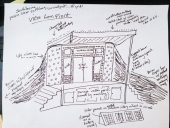posted 6 years ago
I love this idea for more densely settled areas. Also very appealing in harsh, windy climates. Plenty of examples in europe/middle east. Very well suited to environments where thermal mass is effective and insulation not needed. In climates that need insulation, natural insulation options are quite practical for walls, but foundations and to a somewhat lesser degree roofs really benefit from nasty artificial insulation options..
I am a big fan of keeping infrastructure accessible in buildings where possible, despite some costs in terms of design constraints. If your pipes and wires are super easy to access, having to remove them to decommission a house is no big deal. They might even still be of value to someone.
Options for this include exposed conduit/pipe runs in basements and attics, with good access maintained. Wainscotting can hide stuff, and can be easily removed if correctly installed. Ditto dropped ceilings.
It seems to me, that a dwelling in most inhabited areas, is more likely to be occupied by a later inhabitant, than abandoned. Especially, if it is efficient, robust, and perhaps most important, adaptable.
'Theoretically this level of creeping Orwellian dynamics should ramp up our awareness, but what happens instead is that each alert becomes less and less effective because we're incredibly stupid.' - Jerry Holkins









